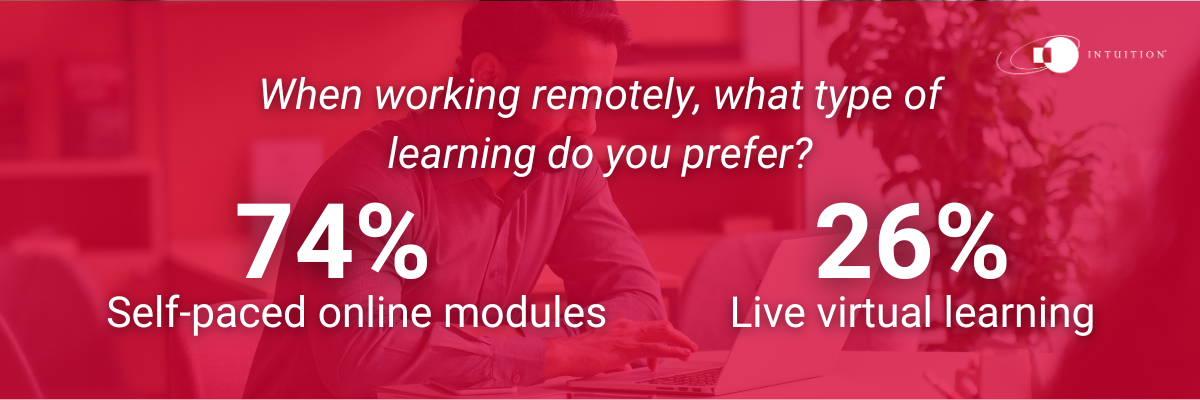Remote learning: What are learners’ preferences?
This article on remote learning is taken from our report ‘Tomorrow’s Lessons Today: Unique insights into the World of Corporate Learning’. Throughout 2023, we asked our online audience a series of questions relating to corporate learning with some interesting results.
To access the full report, click here: Unique Insights into the World of Corporate Learning

Professionals are constantly seeking effective ways to enhance their skills and knowledge. As the corporate learning industry adapts to the demands of the digital age, it is crucial to understand the preferences of remote workers when it comes to learning.
In this particular poll, we focused on the choice between self-paced online modules and live virtual learning.
Self-paced online modules: The preferred remote learning method
According to our poll results, a significant majority of remote workers, 74%, expressed a preference for self-paced online modules. This method of learning allows individuals to navigate their learning journey at their own pace, granting them the flexibility to balance their work and personal commitments effectively. Let’s explore the reasons behind the popularity of this learning approach.
Flexibility and convenience
One of the key advantages of self-paced online modules is the flexibility they offer. Remote workers can access educational materials at their convenience, fitting their learning into their own schedules. This flexibility eliminates the need to adhere to rigid timelines and allows professionals to learn at their own pace, maximizing their understanding and retention of the subject matter.
Personalized remote learning experience
Self-paced online modules empower remote workers to tailor their learning experience to their individual needs. They can choose the topics that align with their specific interests or skill gaps, ensuring they acquire the knowledge that is most relevant to their professional growth. This personalized approach fosters a sense of ownership and motivation, as professionals can focus on areas that directly impact their career development.
Access to diverse learning resources
Online learning platforms often provide a wide range of resources, including videos, interactive quizzes, case studies, and downloadable materials. This diverse set of learning resources caters to different learning styles, ensuring remote workers can engage with the content in a manner that best suits their preferences. Additionally, these resources can be accessed repeatedly, allowing for reinforcement and deeper understanding of the subject matter.
Live and virtual remote learning: An alternative approach
While self-paced online modules emerged as the preferred choice among remote workers, the value of live virtual remote learning should not be underestimated. This method, chosen by 26% of respondents, offers a real-time and interactive learning experience. There are a number of reasons why some professionals opt for this approach.
Real-time interaction and collaboration
Live virtual learning provides an opportunity for remote workers to engage in real-time discussions and collaborate with instructors and fellow learners. This synchronous learning experience fosters a sense of community and allows participants to participate actively in discussions, ask questions, and receive immediate feedback. The interactive nature of live virtual learning can enhance the learning experience and facilitate a deeper understanding of complex concepts.
Structured learning environment
For individuals who thrive in a structured learning environment, live virtual learning offers a clear framework and set schedule. This approach can help remote workers establish a routine and maintain focus during learning sessions. Additionally, the presence of an instructor can provide guidance and clarification, ensuring that participants stay on track and make the most of their learning experience.
Networking and building professional connections
Live virtual learning often brings together professionals from different organizations and industries, creating opportunities for networking and building valuable connections. Remote workers can expand their professional network by engaging with like-minded individuals who share similar interests and goals. The connections made during live virtual learning sessions can lead to collaboration, mentorship, and future career opportunities.
Balancing preferences for optimal learning
The result of our poll reveals the diverse needs and preferences within the corporate learning landscape. While self-paced online modules emerged as the frontrunner, it is important to recognize that a blend of learning methods can be beneficial in maximizing learning outcomes.
Blended learning: The ideal approach
Blended learning, incorporating a combination of self-paced online modules and live virtual learning, can offer a comprehensive and well-rounded learning experience. This approach allows remote workers to leverage the flexibility and personalized nature of self-paced modules while also benefiting from the interactive and collaborative aspects of live virtual sessions. By striking a balance between these two methods, professionals can tailor their learning journey to their individual preferences and learning objectives.

Summary
- As the remote work paradigm continues to shape the corporate learning landscape, it is crucial to understand the preferences of professionals when it comes to learning methods.
- By embracing a blended learning approach, professionals can harness the advantages of both methods, ensuring optimal learning outcomes while working remotely.


